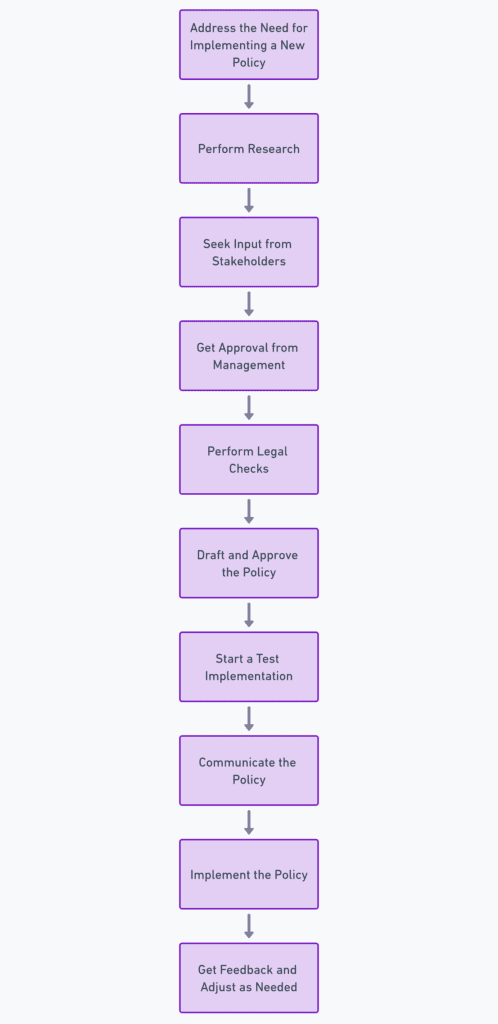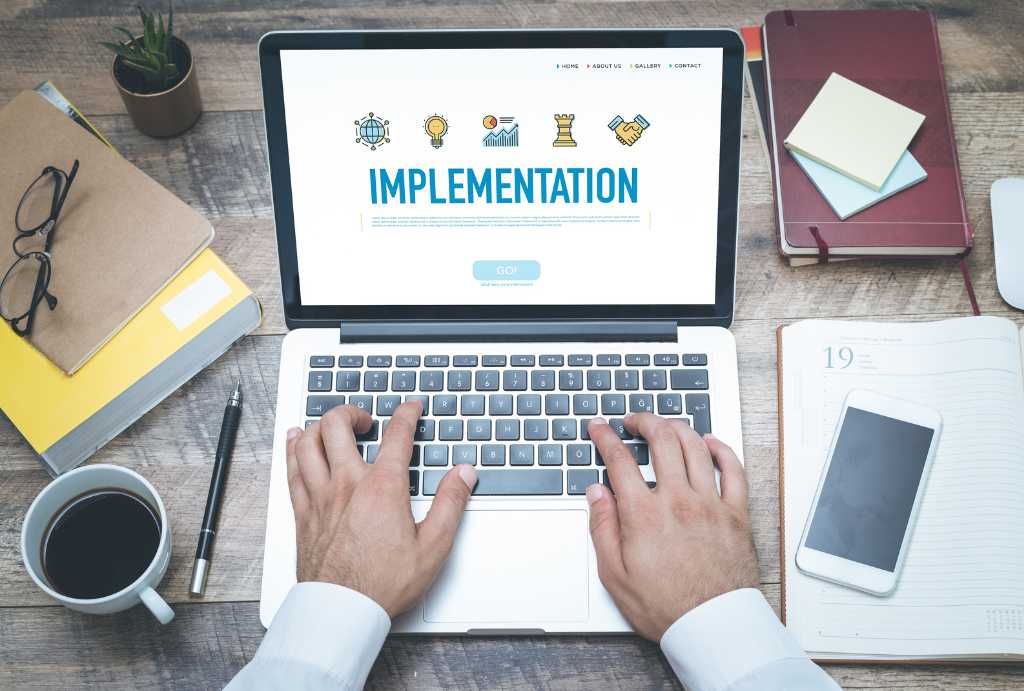Implementing a new company policy usually happens when there is a change needed in the company, an issue needs to be addressed, employee safety and well being need to increased etc. Having company policies that are updated and are parallel with the company’s growth and industry trends is a must. But this needs careful planning, open communication, and constant feedback. Let’s look at how you can implement a new company policy the right way and successfully.
What are Company Policies?
A company policy is a clear set of rules that explains how the company operates and how employees should behave at work. It serves as a simple guide to what is acceptable and what is not.
These policies make sure that business actions are consistent, fair, and efficient. They cover areas like workplace safety, dress code, use of company property, anti-discrimination, conflict resolution, and data privacy. More than just standard rules, policies help define the company’s identity, values, and ethics.
Types of Company Policies
Hiring, promotions, performance evaluations, and disciplinary actions are all handled under human resource policies. They come in handy because they guarantee employee justice and legal compliance by maintaining equality for all employees and their rights.
Examples: Paid leave policies, employee performance review processes, anti-discrimination policies.
Conduct policies are implemented to lay down certain expectations that companies have for their employee’s conduct and professional behavior, so that a certain level of professionalism can be maintained in the workplace. They are vital for tackling problems like harassment, discrimination or inappropriate behavior and preserving a positive work environment.
Examples: Anti-bullying policies, dress code requirements, and workplace etiquette rules.
These type of company policies helps clarify what safety rules the company follows, how employees need to comply with safety regulations and how they can be protected in hazardous situations.. This makes sure employees are treated more humanely, a safe workplace environment is created and all safety laws are followed. Implementing health and safety standards for a company brings about a safe work culture and avoids the risk of lawsuits or accidents.
Examples: Fire safety procedures, first-aid protocols, ergonomic assessments, and equipment safety guidelines.
Operational policies manage a business’s day-to-day activities, guaranteeing that daily operation run and are carried out effectively by the right people, reliably, and in accordance with company goals. Such policies are necessary for keeping high productivity and streamlining workflows. Operational policies can help your company eliminate any confusion regarding work processes, cuts down on errors, and increases output with precise instructions.
Examples: Customer service protocols, quality control checklists, inventory management rules, and equipment usage procedures.
IT policies control how data and technology are used and managed under your company, guaranteeing all IT systems that are used are secure, effective, and legally acceptable. They are essential for preventing any data breaches, protecting company’s important intellectual property, and making sure all cybersecurity laws are followed before implementing a new policy. Every time an employee manages a company software, handles sensitive data, accesses the company network, or reports any technical problems, these policies come handy with precise instructions.
Examples: Data encryption guidelines, password policies, internet usage rules, and cybersecurity protocols.
Having comprehensive legal representation and policies that can help upholding the company’s reputation and image, maintaining client confidence, and avoiding any interruptions in business. These guidelines basically exist to guarantee that the business follows all relevant laws at the local, state, national, and international level. Such laws include labor laws, data security, health and safety, the environment, and financial reporting, among other topics.
Examples: Labor law compliance, tax regulations, anti-bribery policies, and GDPR data protection standards.
Every organization needs a smooth flowing communication system whether it be for consumers, stakeholders or existing employees. In order to do so, communication policies guide a company on how, when, why and what exactly needs to be communicated via specific channels. This helps makes sure there is consistency in brand voice and image.
Examples: Email communication guidelines, social media usage policies, customer communication protocols, and public relations guidelines.
Work schedules that allow employees to work from home or any other place in a specific time frame that allows flexibilty and control is a plus point for employees. such working hours allow attracting and retaining top talent that give value to work life balance. A flexible work policy comes in handy when employees request part time work, telecommuting, WFH etc.
Examples: Remote working guidelines, flexible scheduling policies, and compressed workweek options.
All businesses should place a high priority on sustainability as it guarantees that their work will ultimately benefit the society and the environment. This is where lies the critical role of Corporate Social Responsibility, or CSR. It is the practice that allows companies to accept accountability for their negative effects on the environment, society, and economy. CSR-guided sustainability and environmental policies helps companies in making decisions that limit waste, save resources, and use less energy. These policies demonstrate the company’s commitment to preserving the environment and promoting well-being to all, including investors, customers, and employees.
Examples: Recycling programs, energy-efficient workplace guidelines, carbon footprint reduction initiatives, and policies promoting sustainable sourcing.
Why Do You Need to Implement a New Company Policy?
When there is a need for improvement or change, implementing a new company policy is the only right solution. Such company policies bring about a sense of consistency in structure and clarity for all the people related to the company. These policies will definitely make sure that everyone is aware of their respective expectations and company regulations. You can expect great positive changes by implementing a new company policy with a guarantee for legal compliance, improved safety, and strong employee behavior. New and updated company policies play a huge role in improving a company’s work setting, protect the business and its employees, and create equality throughout the whole company.
In short, here are a few reasons why implementing a new company policy can be useful:
- Modifications to labor laws or regulations
- Taking care of issues related to employee health or safety
- Adjusting to a company’s expansion or merging
- Introducing new techniques or systems
- Defining the roles and responsibilities of employees
- Enhancing the performance or conduct of employees
- Resolving disputes or misbehavior at work
- Optimizing processes to increase productivity
- Increasing cybersecurity and data protection
- Increasing attempts to promote diversity and inclusion
- Meeting sustainability or environmental objectives
- Conforming to industry norms or ideal methods
Steps to Implement a New Company Policy

Steps to Implement a New Company Policy
1. Address the Need for Implementing a New Policy
 If you are looking forward to implementing a new company policy, you should know the reason behind it. This could be any of the reasons listed above or other specific issue. It is extremely important to identify and have in mind a niche reason so that your policy is thoroughly effective. This step comes first for this very reason. You could find out this reason during regular company reviews, audits, employee feedback, or changes in specific laws.
If you are looking forward to implementing a new company policy, you should know the reason behind it. This could be any of the reasons listed above or other specific issue. It is extremely important to identify and have in mind a niche reason so that your policy is thoroughly effective. This step comes first for this very reason. You could find out this reason during regular company reviews, audits, employee feedback, or changes in specific laws.
2. Perform Research
Now you that you know the reason, the next step is to research. This requires extensive research on competitor companies, industry standards, market trends, company legalities etc. The area of research will also depend upon the kind of company policy you are implementing. Let’s say that your company is implementing a new company policy on employee travel. This means that the research will lean towards time taken to travel to and from a certain location, expenses, accommodation, travel safety etc.
3. Seek Input from Stakeholders
Once you have your research and content ready to add to the policy, have a word with your stakeholders. Stakeholders can help you get insights and spot what could be wrong or errors in your policy. This will help you create a policy that will work for everyone without any callbacks. You can get their input via group meetings, emails or in person.
4. Get Approval from Management
 After having gained input directly from the people who would use the new company policy, it’s time to get approval from the higher-ups. For this you will need to prepare a clear, comprehensive and convincing reason and content for the higher management. This will show the management just why this new policy is important, how it will help, who it will benefit and how it’s implementation process will look like. Add in more pointers like cost saving, higher employee productivity, financial security etc; this will highlight the positive effects of implementing a new company policy. Once you have the top management’s approval, it will be easier to bring the new company policy into action company wide.
After having gained input directly from the people who would use the new company policy, it’s time to get approval from the higher-ups. For this you will need to prepare a clear, comprehensive and convincing reason and content for the higher management. This will show the management just why this new policy is important, how it will help, who it will benefit and how it’s implementation process will look like. Add in more pointers like cost saving, higher employee productivity, financial security etc; this will highlight the positive effects of implementing a new company policy. Once you have the top management’s approval, it will be easier to bring the new company policy into action company wide.
5. Perform Legal Checks
 Before implementing a new company policy, it is highly important to work with your company’s legal team or external legal advisors. They can go through the data to make sure your company follows all the regulated laws and make sure you comply to each and every one of them. This will make sure your policy is legally supported and you have a lower risk of lawsuits, fines, or other regulatory issues.
Before implementing a new company policy, it is highly important to work with your company’s legal team or external legal advisors. They can go through the data to make sure your company follows all the regulated laws and make sure you comply to each and every one of them. This will make sure your policy is legally supported and you have a lower risk of lawsuits, fines, or other regulatory issues.
6. Draft and Approve the Policy
7. Start a Test Implementation
Before completely implementing a new policy company wide it is always best advised to start with a test implementation. For this a small group of employees from different departments or department heads are often chosen. These employees are then asked to provide feedback without hesitation via surveys, feedback forms or reports. Your company can also make use of performance tracking and monitoring systems to measure this new policy’s impact and after effects on a smaller level without big implications.
8. Communicate the Policy
With the test implemented policy, you will have a clear idea of how this policy will work company wide and you can then decide how you want to communicate the final policy. It needs to be done in a clear, error free and straightforward manner via meetings, emails, team calls etc. This will include communicating everything from what the new policy is about, why it will be coming into effect, how it affects the company, what steps must be taken and more. Include an extensive list of any questions that would commonly arise in any employee’s mind and step to step guides to simplify the policy. Lastly, to fully prepare each employee for this change, allow employees to know whom they can reach out to incase of any doubts.
9. Implement the Policy
 This is the step where you will actually be putting the policy to use and implementing a new company policy. At this point, the policy is put into effect, and all employees are supposed to abide by it. Team leaders, HR professionals, and department heads play an important role in making sure the policy is followed correctly in all departments. Your company may also need to make certain changes to internal systems to reflect the new policy, such as improving employee handbooks, performance management systems, or compliance tracking software.
This is the step where you will actually be putting the policy to use and implementing a new company policy. At this point, the policy is put into effect, and all employees are supposed to abide by it. Team leaders, HR professionals, and department heads play an important role in making sure the policy is followed correctly in all departments. Your company may also need to make certain changes to internal systems to reflect the new policy, such as improving employee handbooks, performance management systems, or compliance tracking software.
10. Get Feedback and Adjust as Needed
 After your company has fully implemented the new company policy, you will now see it’s effects on your company’s productivity, employees and consumers. So it will be vital to get feedback from the right people on it’s effectiveness and check for areas for improvement. Make use of any monitoring systems, performing reports, feedback forms or other things that will offer you insight on solutions to make the policy perfect. This could mean additional employee training, rephrasing or tweaking the policy and reviewing it periodically.
After your company has fully implemented the new company policy, you will now see it’s effects on your company’s productivity, employees and consumers. So it will be vital to get feedback from the right people on it’s effectiveness and check for areas for improvement. Make use of any monitoring systems, performing reports, feedback forms or other things that will offer you insight on solutions to make the policy perfect. This could mean additional employee training, rephrasing or tweaking the policy and reviewing it periodically.
FAQs
How do you gather feedback on a new policy?
To find out how well the policy is functioning and what needs to be improved, you can ask employees directly or through surveys and team meetings.
How do you introduce a new policy and procedure?
Introduce new policies by outlining the main changes, justifying them, and, if required, providing training. Make sure that all staff members can understand and access the communication.
Why is it important to involve employees in policy changes?
By giving employees a sense that their opinions count, involving them in policy changes helps to guarantee that the policy is workable, increases buy-in, and decreases opposition.
When is it necessary to review or update company policies?
Regular reviews and updates of corporate policies are necessary, particularly in the event of legal, industry, or major internal changes such as the introduction of new technology or the restructuring of the company.
Why is testing a new policy important before full implementation?
Testing makes it easier to make changes before the policy is implemented throughout the entire organization by helping you to find any problems or misconceptions at a smaller scale.
Conclusion
Implementing a new company policy the right way is important for maintaining effective performance, regulatory compliance, and a positive work environment. When implemented correctly, company policies give employees clear guidelines, promote consistency, and help resolve issues before they escalate. An effective company policy ensures everyone understands their roles and responsibilities.
To make this process even easier, Smart Sales Kit offers a powerful solution by providing over 150 legally compliant, ready-to-implement company policies. With just a single click, you can access professionally designed templates that save you time and ensure accuracy. Smart Sales Kit simplifies policy creation by covering everything from compliance to clarity, making it easier for businesses to maintain consistency and meet legal standards. Whether you’re a small business or a large corporation, we equip you with the tools needed to implement policies quickly and efficiently.


